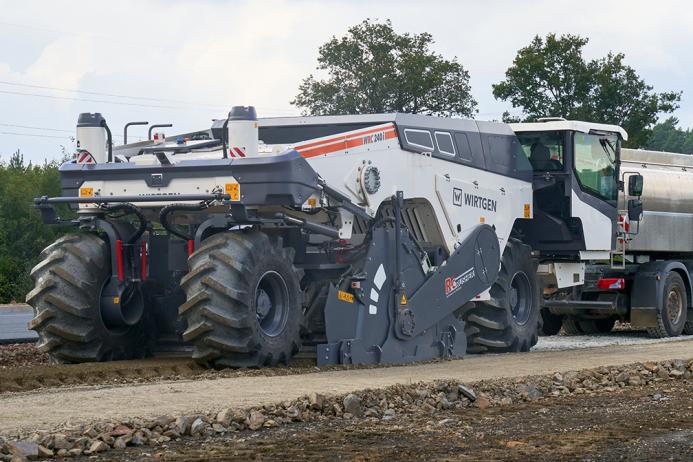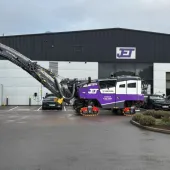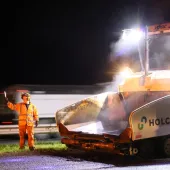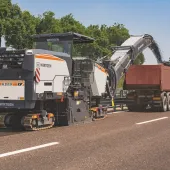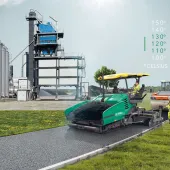Wirtgen launch the WRC 240(i) Rock Crusher
New specialist machine for layer processing in road construction and soil stabilization
THE new WRC 240(i) Rock Crusher from Wirtgen breaks coarse rocks in situ, as found in hand-packed pavement layers (eg Telford bases) or stony soils and produces a homogeneous mix in a continuous process. Its working width of 2,320mm and working depth of up to 510mm enables an output of up to 600 tonnes/h.
The WRC 240(i) expands Wirtgen’s portfolio of wheeled soil stabilizers designed especially for the processing of stony ground. In addition to the crushing of rocks and stones with an edge length of up to 300mm and a compressive strength of up to 200MPa, the machine can add cement and water in the same pass, eg in the preparation of base layers. Here, cement is pre-spread with a binding agent spreader and the water required is sprayed into the mixing chamber of the Rock Crusher via the machine’s Varioinjection bar.
The machine can also be used for soil stabilization. For this application, pre-spread binding agents such as lime or cement are mixed into existing soil with insufficient bearing capacity, transforming it in situ into a high-grade construction material and depositing it evenly behind the machine.
The main task of the WRC 240(i) is the granulation and mixing of a variety of soils, courses, and layers to produce a homogeneous final product in a continuous process. As opposed to the removal and replacement of material, the processes here are characterized by shorter construction times, conservation of resources, and lower CO2 emissions.
The rugged and resilient crushing and mixing rotor with toolholders developed especially for crushing applications with the HT18 delivers optimal results when working in stony ground. The tools are fitted with large, impact-resistant carbide cutting edges and the holder bases are protected by wear-resistant protective elements made from high-tensile steel. This ensures high machine utilization rates and process reliability in demanding applications. Robust edge protectors reduce wear on the rotor’s edge ring segments. The rotor is driven via a transmission developed especially for the WRC 240(i) that enables the realization of high rotor speeds.
In order to ensure long-term resistance to the huge stresses encountered when crushing rocks, the rotor housing of the Rock Crusher is lined with abrasion-resistant wear plates made from extremely tough high-tensile steel. These guarantee a longer service life and increase the overall stability of the housing. The entire mixing chamber is lined with these extremely hard-wearing plates, which can be individually replaced if and when required.

The WRC 240(i) offers several setting options that enable the achievement of the desired grain size and consistently uniform distribution in a wide range of applications. Nine rotor speeds, a variable crushing stage, exchangeable screens with a range of clear mesh sizes and adjustable distance from the rotor, and adjustable rotor plate pressure and machine advance allow configuration of the machine to meet the needs of actual site conditions and the desired application.
By enabling precise, automatic steering, the satellite-based AutoTrac system helps the WRC to achieve greater process efficiency and, as a result, a high degree of environmental compatibility. It steers the machine accurately within tolerances of a few centimetres on the basis of a previously calculated reference strip and a specified overlap of adjacent strips, which allows consistent utilization of the machine’s ideal working width. The Wirtgen Performance Tracker (WPT) registers all relevant location-specific working parameters to provide a comprehensive database for analysis and documentation of the construction site.
The global market launch of the Rock Crusher takes place this month (November 2023).

